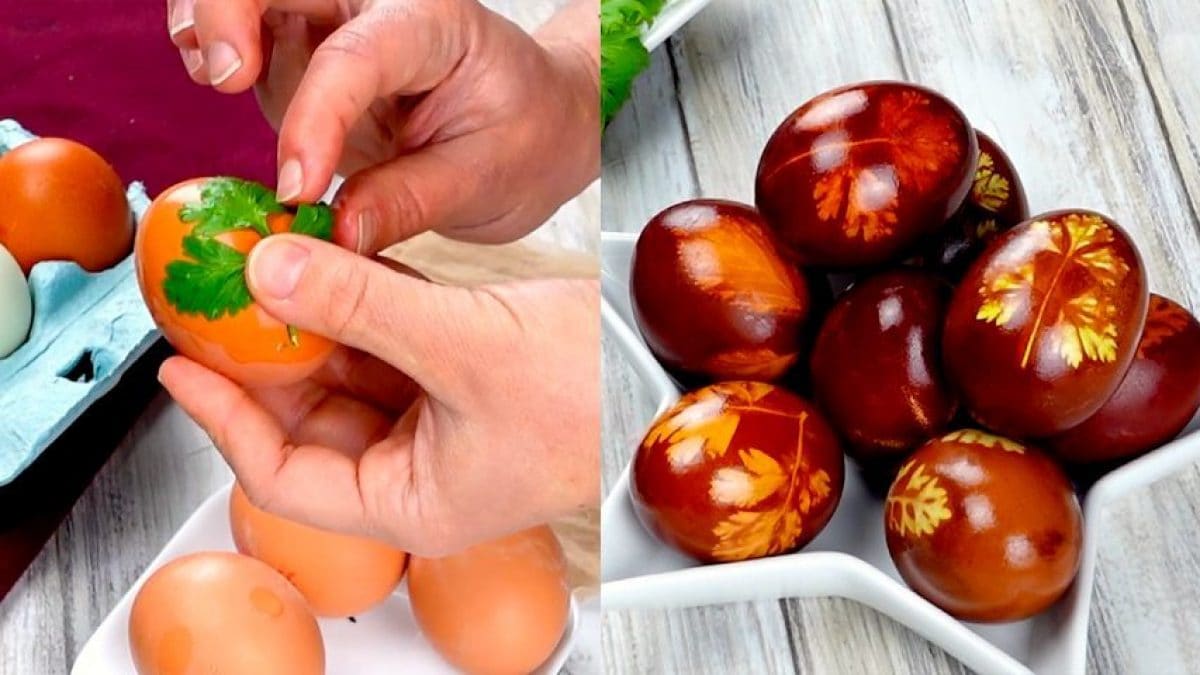
If you are looking for an Easter egg recipe with natural dyes, look no further than this recipe for Onion Dyed Easter Decorated Eggs. The recipe involves soaking hard-boiled eggs in water that has been infused with the color from red onion skins and shallot skins. With their beautiful earthy color, these eggs are wonderful to enjoy over the Easter holidays with your breakfasts.
To make these onion dyed Easter eggs, you first boil red onion and shallot skins in water. Then, you adhere herb leaves on the eggs for decoration before wrapping them in nylon and soaking them in the infused water. Once coloured, the eggs are then removed and unwrapped. You can also use a cotton swab and lemon juice to mark the dyed egg up and create pretty designs.
What are Onion Dyed Easter Eggs?
These onion dyed Easter eggs are hard-boiled eggs that are colored with water that has been infused with onion skins. Many people like to simply add store-bought food coloring to water to soak their hard-boiled eggs in to color them for Easter, but that type of food coloring isn’t necessarily healthy due to artificial colors and dyes. In fact, store-bought food coloring that includes artificial ingredients has been linked to a rise in ADHD, cancer, and challenges with the nervous system. Fortunately, artificial food dyes don’t need to be used to color Easter eggs as you can derive color from natural foods like onion skins.
Pro Tips
- If you don’t have red onion skins on hand, you could also use skins from regular yellow or white onions instead. The colour of the eggs will just be more brown than red or purple.
- You can choose herbs like parsley, cilantro, rosemary, thyme, or dill to decorate the outside of your eggs.
- If you don’t have any lemon juice on hand for marking up the eggs after they are dyed, you could use some white vinegar instead.
- If you don’t have nylons to use for dying the eggs, you could use cheesecloth instead.
- Feel free to infuse ingredients other than onion skins in water to dye the eggs different colors. Infusing water with beets will turn the eggs pink whereas red cabbage will give the eggs a deep blue color, and turmeric will give the eggs a yellow color.
What to Serve with Onion Dyed Easter Eggs?
These onion dyed Easter eggs are a wonderful accompaniment to any Easter breakfast along with fresh bread, bacon, ham, fresh fruit, and more.
Can You Dye Brown Eggs?
Yes, you definitely could! Since red onion skins make such a deep burgundy colored dye, it will color both brown and white eggs alike.
Can I Use Brown Onion Skins Rather Than Red?
Yes, brown onion skins will also produce a nice dye for your eggs. It will just give them an earthier brown color rather than a red color.
Is It Better to Dye Easter Eggs Warm or Cold?
You should dye these Easter eggs in warm water. The onion and shallot peelings need to be boiled to release their natural dyes, so the water should be heated to bring out the color. After boiling for about an hour, the eggs are then boiled in this warm dye solution to absorb the color.
What Other Natural Ingredients Can Be Used to Dye Eggs?
If you would like to dye your eggs different colors, you could follow this recipe but replace the onion skins with other ingredients instead. For example, infusing turmeric in water will create a yellow-orange dye while beets will help create a red dye. Meanwhile, blueberries can create a deep purple dye while purple cabbage can create a deep blue or turquoise dye.
How to Store Onion-Dyed Easter Eggs
These Easter eggs should be stored in the fridge in an airtight container until you are ready to serve them. They should keep for up to 1 week.
Ingredients
How to Make Onion Dyed Easter Eggs

Place the red onion and shallot skins in a pot and cover them with water. Bring it to a boil; allow the mixture to sit for 1 hour.
Place the red onion and shallot skins in a pot and cover them with water. Bring it to a boil; allow the mixture to sit for 1 hour.

Cut several squares out of the stockings and select several leaves for decorating the eggs.
Cut several squares out of the stockings and select several leaves for decorating the eggs.

Rub water on each egg and press a leaf on them to help them stick. Wrap each egg with a piece of the stockings and tie them off with a rope.
Rub water on each egg and press a leaf on them to help them stick. Wrap each egg with a piece of the stockings and tie them off with a rope.

Reheat the pot with the onion peelings for 5 minutes. Add the eggs and boil them for 10 minutes.
Reheat the pot with the onion peelings for 5 minutes. Add the eggs and boil them for 10 minutes.

Remove the eggs, unwrap them, and peel off the leaves. Grease the eggs with butter. If desired, you can use a cotton swab and lemon juice to create designs in the eggs.
Remove the eggs, unwrap them, and peel off the leaves. Grease the eggs with butter. If desired, you can use a cotton swab and lemon juice to create designs in the eggs.

Serve the eggs once they are chilled.
Serve the eggs once they are chilled.

;Resize,width=767;)
